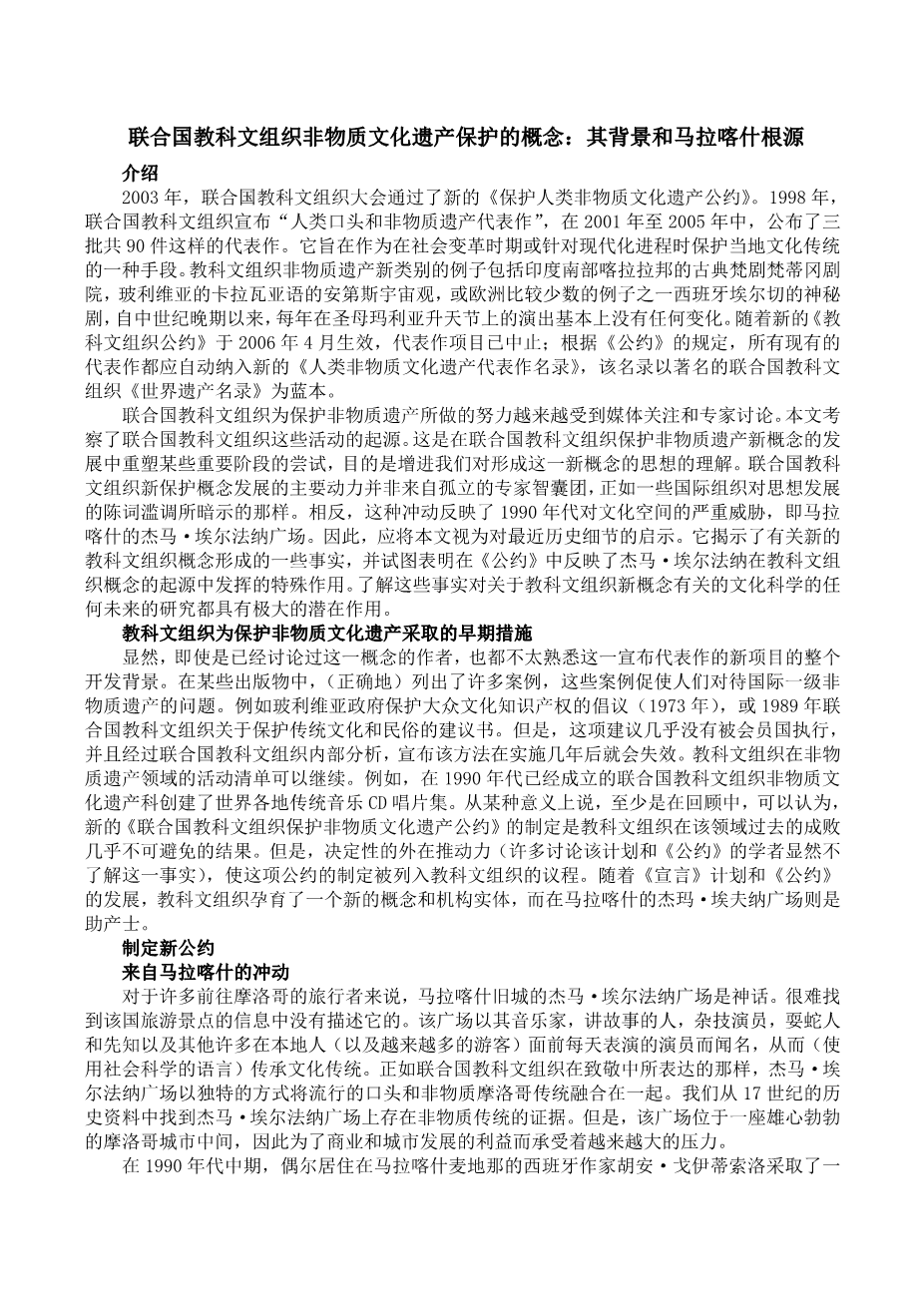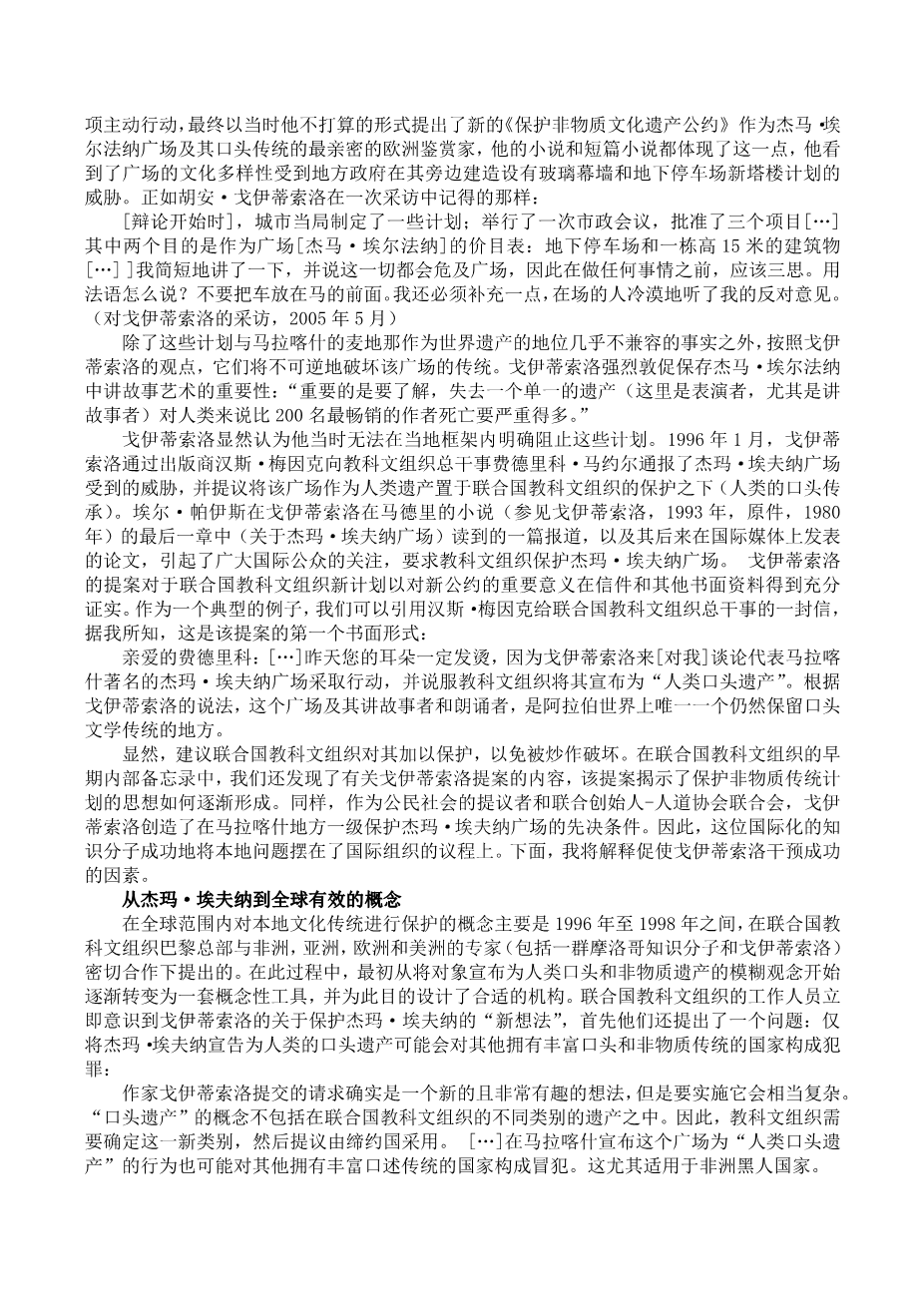非物质文化遗产保护的现实困境与对策研究外文翻译资料
2022-08-09 10:54:23
The UNESCO Concept of Safeguarding Intangible Cultural Heritage: Its Background and Marrakchi Roots
Introduction
In 2003 a new Convention for the Safeguarding of the Intangible Cultural Heritage of Humanity was adopted by UNESCOrsquo;s General Assembly. In 1998 UNESCO had already started a programme for the Proclamation of Masterpieces of the Oral and Intangible Heritage of Humanity, and a total of 90 objects were proclaimed as such Masterpieces in three proclamation rounds between 2001 and 2005. The proclamation programme and the new Convention based on it are intended as a means of protecting local cultural traditions in times of social change or in the face of certain modernisation processes. Examples of the new UNESCO category of intangible heritage are the Kutiyattam Sanskrit Theatre in the southern Indian province of Kerala, the Andean Cosmovision of the Kallawaya in Bolivia, or—one of the comparatively few European examples—the Mystery Play of Elche, Spain, which has been staged largely unchanged every year on the Feast of the Assumption of the Blessed Virgin Mary since the late Middle Ages.With the entry into force of the new UNESCO Convention in April 2006, the Masterpieces programme was discontinued; under the terms of the Convention, all existing Masterpieces should be entered automatically in the new Representative List of the Intangible Cultural Heritage of Humanity, which is modelled on the well-known UNESCO World Heritage List.
UNESCOrsquo;s new efforts to protect the intangible heritage are receiving increasing attention from the media and in discussions among experts. This paper examines the genesis of these UNESCO activities. It is an attempt to reconstruct some of the important stages in the development of the new UNESCO concept for the protection of intangible heritage, with the aim of increasing our understanding of the ideas which shaped this new concept. The main impulse for the development of UNESCOrsquo;s new protection concept did not come from isolated expert think tanks, as some clicheacute;s on the development of ideas in international organisations would suggest. Rather, this impulse reflects the acute threat in the 1990s to a cultural space, namely Jemaa el Fna Square in Marrakech. This paper should therefore be seen as shedding light on a detail of recent history. It reveals some facts concerning the development of the new UNESCO concept, and it attempts to show to what extent the special role played by Jemaa el Fna in the genesis of the UNESCO concept is reflected in the Convention. A knowledge of these facts is of great potential interest for any future research in the cultural sciences relating to the new UNESCO concept.
Early Measures Taken by UNESCO for the Preservation of Intangible Cultural Heritage
The full background of the development of this new programme for the proclamation of Masterpieces is obviously not familiar even to authors who have discussed the concept.. In some publications, a number of events are (correctly) listed which prompted treatment of the question of intangible heritage at an international level, for instance an initiative by the government of Bolivia to protect the intellectual property rights of popular culture (1973), or the UNESCO Recommendation on the Safeguarding of Traditional Culture and Folklore of 1989. However, this recommendation was hardly implemented by the member states, and internal UNESCO analyses declared it to be ineffective just a few years after it was adopted. This list of UNESCO activities in the area of intangible heritage could be continued. For instance, in the 1990s the UNESCO Section for Intangible Cultural Heritage, which had already been set up, created a collection on CD of traditional music from all over the world. In a way, at least in retrospect, the development of the new UNESCO Convention for the Safeguarding of the Intangible Cultural Heritage could be construed as an almost unavoidable consequence of UNESCOrsquo;s previous successes and failures in this field. However, it took a decisive external impulse (and many authors who discuss the programme and the Convention which grew out of it are obviously not aware of this fact) to get the development of a convention placed on the agenda at UNESCO. With the development of the Proclamation programme and the Convention, UNESCO was giving birth to a new conceptual and institutional entity, and it was Jemaa el Fna Square in Marrakech which acted as the midwife.
Towards the Development of a New Convention
The Impulse from Marrakech
For many travellers to Morocco, Jemaa el Fna Square in the old city of Marrakech is the stuff of myth; it would be difficult to find an account of the countryrsquo;s tourist attractions that fails to describe it. The square is known for its musicians, storytellers, acrobats, snake charmers and seers, and the many other actors who perform daily in front of a local (and increasingly also tourist) audience and thereby—to use the language of social sciences—reproduce and modify cultural traditions. As expressed by UNESCO in its tribute, Jemaa el Fna Square brings together popular oral and intangible Moroccan traditions in a unique way. We find evidence of the existence of intangible traditions on Jemaa el Fna Square in historical sources dating from the 17th century. However, the square is located in the middle of an aspiring Moroccan city and has thus been exposed to increasing pressures in the interest of commercial and urban development.
In the mid-1990s, the Spanish writer Juan Goytisolo, who occasionally lives in the Medina of Marrakech, took an initiative which finally—and in a form not intended by him at the time—led to the new Convention for the Safeguarding of the Intangible Cultural Heritage. As perhaps the most intimate European connoisseur of Jemaa el Fna Square and its oral traditions, both of which fi
剩余内容已隐藏,支付完成后下载完整资料


英语译文共 4 页,剩余内容已隐藏,支付完成后下载完整资料
资料编号:[239440],资料为PDF文档或Word文档,PDF文档可免费转换为Word




